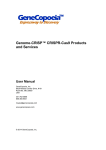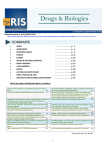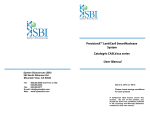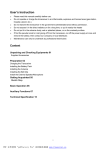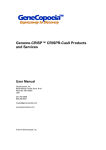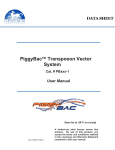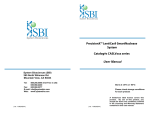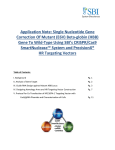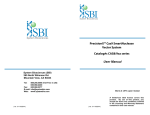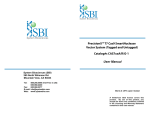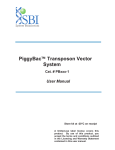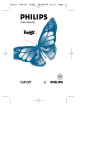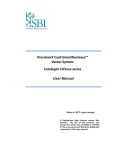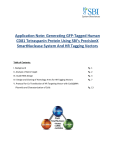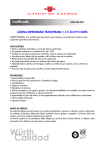Download PrecisionX ™ HR Targeting Vectors
Transcript
PrecisionX ™ HR Targeting Vectors Cat #s HRxxxPA-1, . PBHR100A-1 User Manual Store Kits at-20ºC upon receipt A limited-use label license covers this product. By use of this product, you accept the terms and conditions outlined in the Licensing and Warranty Statement contained in this user manual. PrecisionX TM Vectors Cat. # HRxxxPA-1, PBHR100A-1 Contents I. Introduction ................................................................................2 A. Overview of Genome Engineering Tools ............................2 TM B. Overview of PrecisionX Targeting Vectors for HR-Based Applications .................................................................................5 C. Design Considerations for Homologous Recombination Arms ............................................................................................8 TM II. PrecisionX Targeting Vectors By Application: Gene KnockOut…………. .............................................................................10 A. Overview of Gene Knock-Out ...........................................10 B. Validation Data for HR110PA-1 ........................................14 C. Additional Materials Required ...........................................17 D. General Considerations ....................................................18 E. Cloning of Homology Arms into Vector .............................19 F. Protocol for Co-Transfection of Targeting Vector with TALEN or Cas9 plasmids and Characterization of Cells ..........22 TM III. PrecisionX Targeting Vectors By Application: Gene KnockIn………………. ............................................................................24 A. Overview of Gene Knock-In ..............................................24 B. Additional Materials Required ...........................................25 C. General Considerations ....................................................26 D. Cloning of Homology Arms and Expression Cassette into Vector ........................................................................................27 E. Protocol for Co-Transfection of Targeting Vector with TALEN or Cas9 plasmids and Characterization of Cells ..........30 TM IV. PrecisionX Targeting Vectors By Application: Gene Tagging .........................................................................................32 888-266-5066 (Toll Free) 650-968-2200 (outside US) Page 1 System Biosciences (SBI) User Manual A. Overview of Gene Tagging………..………………………..32 B. Additional Materials Required ...........................................38 C. General Considerations ....................................................39 D. Cloning of Homology Arms into Vector .............................39 E. Protocol for Co-Transfection of Targeting Vector with TALEN or Cas9 plasmids and Characterization of Cells ..........44 TM V. PrecisionX Targeting Vectors By Application: Gene Editing. ..........................................................................................46 A. Overview of Gene Editing .................................................48 B. Additional Materials Required ...........................................48 C. General Considerations ....................................................49 D. Design and Cloning of Homology Arms into Vector ..........49 E. Protocol for Gene Editing with TALEN/Cas9 system and piggyBac HR vector ...................................................................55 I. VI. References ........................................................................57 VII. Technical Support .............................................................59 VIII. Licensing and Warranty Statement ...................................59 Introduction A. Overview of Genome Engineering Tools Recent advances in tools available for precise genome engineering of target cells have revolutionized the field of biology. The first of these revolutionary tools, zinc finger nuclease (ZFN) technology, has demonstrated that it can be successfully employed to introduce a double-stranded DNA break at a defined location in the mammalian genome to introduce transgenes by homologous recombination (HR) Page 2 ver. 11 - 072114 www.systembio.com TM PrecisionX Vectors Cat. # HRxxxPA-1, PBHR100A-1 (Hockemeyer et al. 2009). This finding has since spurred follow-up studies using HR-based approaches to disrupt endogenous gene function and track cells that have been modified by ZFNs. However, inherent limitations of the ZFN technology have driven researchers to look at other alternatives that would be able to 1) target any sequence of interest with efficiencies rivaling ZFNs 2) increased predictability of targeting and 3) cost-effective to implement for routine use in laboratories around the world. Recent work with transcriptional activatorlike effector nucleases (TALENs), first described in the plant pathogen Xanthomonas sp., have shown that researchers can efficiently target any genomic DNA sequence using a pair of custom TALEN proteins whose DNA-binding modules can recognize individual DNA nucleotides based on an elegant amino acid cipher (Boch et al. 2009). Based on the explosion of recent publications that have successfully demonstrated the utility of the TALEN platform in many eukaryotic model organisms ranging from zebrafish to humans, it has quickly established itself as the de facto platform for genome engineering. While TALEN technology has been gaining acceptance in the research community, the continual advances being made in this field has uncovered another novel, yet potentially powerful tool for genome engineering based on a bacterial system for combating invading viral and nucleic acid sequences, termed CRISPR/Cas9. Originally discovered in the pathogenic bacterium Streptococcus pyogenes, this system uses an unusual series of short RNAs (collectively termed as “guide RNA”) to specifically target a complementary DNA sequence, and upon binding, leads to recruitment of an endonuclease called Cas9 to specifically induce a double-stranded break (DSB) in the DNA sequence targeted by the guide RNA (Bhaya et al. 2011, Jinek et al. 2012). Similar to TALENs, the 888-266-5066 (Toll Free) 650-968-2200 (outside US) Page 3 System Biosciences (SBI) User Manual introduction of DSBs in the DNA leads to recruitment of the cellular repair machinery to drive non-homologous end-joining (NHEJ) processes in absence of homologous sequences, whose error-prone nature often leads to formation of indels in the targeted DNA sequences. The main advantage of the CRISPR/Cas9 system over the TALEN system is that it only requires an oligonucleotide sequence complementary to the target sequence in the format N20NGG (where N=any nucleotide) to effect cleavage, which is much easier and less time-consuming than other technologies. With a simple design of an oligo sequence to target any gene or non-coding sequence, this opens up possibilities for precise, multiplexed genome engineering that would have been unthinkable even a few years ago. However, in order to fully leverage the powerful nature of these genome engineering platforms, there needs to be a set of ancillary tools that will allow detection of cells that have been modified by ZFN, TALEN or Cas9 systems. The majority of genome editing events affect only a percentage of the total population of transfected cells, estimated at 1-80% for mono or bi-allelic modifications depending on the platform, the cell type, and the DNA target of interest. Due to the wide variation in activity, performing downstream phenotypic assays in a background of wild-type cells is challenging, especially if the phenotype in question is subtle or difficult to discern. Therefore, tools in the form of donor or targeting vectors that contain 1) fluorescent or antibiotic selection markers and 2) a gene fragment of interest to knock-in, knock-out, or correct a wild-type sequence will be extremely useful for obtaining a homogeneous population of cells whose genomes have been modified by ZFN, TALEN or Cas9 systems. These vectors, when co-transfected into target cells along with ZFNs, TALEN or Cas9 vectors will take advantage of intrinsic homologous recombination (HR) processes conserved across all organisms for accurate repair of DSBs and insertion of exogenous gene or marker of interest. This is made possible Page 4 ver. 11 - 072114 www.systembio.com TM PrecisionX Vectors Cat. # HRxxxPA-1, PBHR100A-1 by the fact that HR efficiencies are increased >1000-fold in the presence of a homologous donor sequence in mammalian cells (Choulika et al. 1995), making this a tractable approach to characterize phenotypic changes associated with gene targeting and potentially useful as a platform for gene therapy applications. B. Overview of PrecisionXTM Targeting Vectors for HR-Based Applications We have generated a suite of homologous targeting vectors suitable for the purpose of engineering both protein coding and non-coding genes including microRNAs and LncRNAs (see Table 1): Table 1. List of Available PrecisionXTM HR Targeting Vectors By Application 1) Gene Knock-Out Cat# HR110PA-1 HR210PA-1 HR410PA-1 HR510PA-1 888-266-5066 (Toll Free) Description HR Targeting Vector w/Dual Selection Markers (RFP+Puro) HR Targeting Vector w/Dual Selection Markers (GFP+Puro) and TK (for negative selection) HR Targeting Vector w/Dual Selection Markers (GFP+Puro) HR Targeting Vector w/Dual Selection Markers (RFP+Hygromycin) 650-968-2200 (outside US) Size 10 µg 10 µg 10 µg 10 µg Page 5 System Biosciences (SBI) User Manual 2) Gene Knock-In Cat# Description Size HR100PA-1 Basic HR Targeting Vector For Gene Knock-In or Knock-Out (MCSs only) 10 µg 3) Reporter Gene Tagging & Co-Expression Cat# HR120PA-1 HR130PA-1 HR150PA-1 HR180PA-1 HR220PA-1 Description GFP-Fusion HR Targeting Vector (w/EF1a-RFP-T2A-Puro cassette) T2A-GFP Co-Expression HR Targeting Vector GFP-T2A-Luciferase HR Targeting Vector (GFP-Fusion with Co-expressed Luciferase) IRES-GFP Co-Expression HR Targeting Vector GFP-Fusion HR Targeting Vector (w/EF1a-RFP-T2A-Hygro cassette) Size 10 µg 10 µg 10 µg 10 µg 10 µg 4) Gene Correction Cat# PBHR100A-1 Page 6 Description piggyBac-based HR Donor Vector with GFP+Puro markers and TK (for negative selection) ver. 11 - 072114 Size 10 µg www.systembio.com PrecisionX TM Vectors Cat. # HRxxxPA-1, PBHR100A-1 Key Features: 1) Dual markers: Homology-directed recombination using an exogenously supplied vector can result in targeted gene addition. To facilitate the enrichment and selection of HR modified cells, fluorescent markers (RFP and GFP) and positive selection markers (Puromycin or Hygromycin depending on vector format) are built into the HR vectors. The EF-1α alpha promoter is chosen to drive the dual marker expression because EF-1α promoter tends to be active in most cell types, including primary and stem cells. 2) Insulation: To ensure the expression of knock-in genes, insulation sequences are placed on both sides of the expression cassette. This feature ensures the knock-in cassette minimally impacts neighboring genes, and is not silenced by the local environment where the knock-in cassette has been placed. 3) Built-in LoxP Sites. The built-in LoxP sites allow for conditional knock-in/knock-out. In addition, by removal of knock-in genes via CRE, the HR targeting vector can be reused to knockout another allele if double knockouts have not been achieved during the first attempt. 4) Extra MCS. Extra MCS are available for researchers who wish to implement more complicated applications such as gene correction, expression monitoring, and gene therapy. Note: Above features do not apply to PBHR100A-1 vector except for insulators. PBHR100A-1 vector requires the use of the Excision-Only SuperPiggyBac transposase enzyme (Cat. no. PB220PA-1) for removal of selection cassette present in the vector. 888-266-5066 (Toll Free) 650-968-2200 (outside US) Page 7 System Biosciences (SBI) User Manual C. Design Considerations Recombination Arms for Homologous With several different genome engineering tools available TM to induce targeted DSBs, such as SBI’s EZ-TAL TALEN kit(http://www.systembio.com/tale-effectortechnology/nuclease) and Cas9 SmartNuclease system (http://www.systembio.com/genome-engineering-cas9crispr-smartnuclease), there is a need for suitable vectors that will serve as the guide template to induce HR in cells that have been targeted using the aforementioned tools. A general targeting vector will contain the following features: 1) Homologous sequences (to the template with DSBs) at 5’ and 3’ ends of the DSB site. 2) An expression cassette bearing a promoter, insert (cDNA, microRNA, non-coding RNA, etc.), fluorescent marker, or selection agent to select cells that have undergone HR. The 5’ and 3’ homologous sequences (termed “homology arms”) should be exactly homologous to the template with the DSB, and preferably adjacent to the actual DSB site. For TALEN-mediated cleavage, this would entail designing homology arms that are adjacent to the spacer region between TALEN binding sites, which spans 1530bp and is the site of the DSB. An example of homology arm design is shown in Figure 1. Page 8 ver. 11 - 072114 www.systembio.com PrecisionX TM Vectors Cat. # HRxxxPA-1, PBHR100A-1 Figure 1. Schematic Diagram of TALEN-mediated Homologous Recombination (HR) Process In this figure, a region of the human AAVS1 locus (in blue) that is targeted by a pair of TALENs is used for inserting an EF1α-RFP-T2A-Puro expression cassette (in red) present in the HR targeting vector. The HR targeting vector also bears homology arms at the 5’ and 3’ end of the expression cassette that contains ~0.8kb of sequence homology to the genomic DNA surrounding the AAVS1 locus. This region of homology is crucial for the success of the homologous recombination reaction, as it serves as the guide template for specifically targeting the exogenous cassette into this genomic locus. The typical range of sizes for homology arms varies by the application, but it should be anywhere from 0.5kb to 1kb for each arm for efficient recombination to occur. Please note that the actual regions of recombination (Red “Xs”) at the 5’ and 3’ of the target site can vary widely, thus it is difficult to predict the actual sites as this is determined by the cell. For Cas9 system, the cleavage site is 2-3bp upstream of the protospacer adaptor motif (PAM) immediately following the guide RNA sequence, thus homology arms 888-266-5066 (Toll Free) 650-968-2200 (outside US) Page 9 System Biosciences (SBI) User Manual should be designed so that it is close as possible to the cut site (<10bp) at both ends for efficient HR reaction. Figure 2. Schematic Diagram of Cas9-mediated Homologous Recombination (HR) Process II. PrecisionXTM Targeting Vectors By Application: Gene Knock-Out A. Overview of Gene Knock-Out For HR-based applications needing the disruption of a particular protein-coding or non-coding gene of interest, a gene-knockout targeting vector would be desirable. This vector would include homology arms (0.5kb-1kb in length) at the 5’ and 3’ regions immediately flanking the DNA sequence of interest (e.g. exonic sequence) to specifically direct the targeting vector to insert an expression cassette where the targeted sequence lies, leading to the ‘knockout’ of the sequence by gene addition. SBI’s gene Page 10 ver. 11 - 072114 www.systembio.com TM PrecisionX Vectors Cat. # HRxxxPA-1, PBHR100A-1 knockout targeting vectors (Cat #HR110PA-1, HR210PA1, HR410PA-1, and HR510PA-1) are designed to be vectors of choice for this application. Gene-specific homology arms can be cloned into MCS1 and MCS2 to direct ZFN, TALEN or Cas9-mediated gene disruption. Correctly disrupted cell lines are selected as RFP-positive (GFP for HR210PA-1 and HR410PA-1) and puromycinresistant colonies (hygromycin for HR510PA-1). An example of targeting by HR110PA-1 targeting vector is shown in Figure 7. In addition, the selection cassette is fully removable by expression of Cre recombinase (not included). SBI also offers a customizable version of HR110PA-1 without the RFP-T2A-Puro selection cassette (Cat #HR100PA-1, see Section III). This vector contains a MCS which allows the user to insert their own cassette of choice to knock-out a particular sequence of interest. Figure 3. Schematic Diagram of HR110PA-1 Gene Knock-out Targeting Vector [MCS1-EF1-RFP-T2APuro-pA-MCS2] 888-266-5066 (Toll Free) 650-968-2200 (outside US) Page 11 System Biosciences (SBI) User Manual Figure 4. Schematic Diagram of HR210PA-1 Gene Knock-out Targeting Vector [MCS1-EF1-GFP-T2APuro-P2A-TK-pA-MCS2] Figure 5. Schematic Diagram of HR410PA-1 Gene Knock-out Targeting Vector [MCS1-EF1-GFP-T2APuro-pA-MCS2] Page 12 ver. 11 - 072114 www.systembio.com PrecisionX TM Vectors Cat. # HRxxxPA-1, PBHR100A-1 Figure 6. Schematic Diagram of HR510PA-1 Gene Knock-out Targeting Vector [MCS1-EF1-RFP-T2AHygro-pA-MCS2] Figure 7. Example of HR110PA-1 Gene Knock-out Targeting Vector Utilized for Gene Targeting 888-266-5066 (Toll Free) 650-968-2200 (outside US) Page 13 System Biosciences (SBI) User Manual B. Validation Data for HR110PA-1 1) Functionality of Dual Selection Markers The dual positive selection markers, RFP and Puromycin resistance gene have been functionally validated in human HEK293T cells. Cells become RFP and puromycin-resistant 48 hours after initial transfection (Fig. 8). EF1α promoter is a robust promoter that is active most cell types, including primary and stem cells. HEK293T+Plasmid HEK293T w/o Plasmid Figure 8. RFP and Puromycin-Resistance in HEK293T Cells Transfected with HR110PA-1 Targeting Vector 2) Robustness of Insulators in Preventing Silencing of Expression Cassette To ensure that integration of expression cassette will not be inactivated by epigenetic modifications or influenced by neighboring sequences, insulator sequences are implemented in HR vectors. Cells with successful HR events show prolonged RFP-positivity and persistent puromycin-resistant for more than 3 months in culture (Fig. 9). Page 14 ver. 11 - 072114 www.systembio.com PrecisionX TM Vectors Cat. # HRxxxPA-1, PBHR100A-1 Figure 9. HR-modified HEK293T Cells using Targeting Vector Remain RFP-Positive and Puromycin-Resistant for More Than 3 Months 3) Excision of Expression Cassette with Cre/LoxP System The HR knock-out targeting vectors contain LoxP sites flanking the expression cassette (“floxed”) which can be used to easily remove the expression cassette in the presence of Cre recombinase (Fig. 10) by the wellvalidated LoxP-Cre excision reaction. This feature of the donor vector allows for conditional expression of the cassette and phenotype screening in the cell line of interest. 888-266-5066 (Toll Free) 650-968-2200 (outside US) Page 15 System Biosciences (SBI) User Manual Figure 10. Transfection of a CRE-GFP Construct Results in Efficient Abrogation of Floxed RFP-Puro Cassette Expression in HEK293T Cells 4) Validation of HR By Genotyping We have designed a series of PCR primer pairs for the 5’ and 3’ homology arms to confirm the HR event has occurred in the targeted locus of interest. By using one of the primers in the primer pair to bind to the genomic site (either 5’ or 3’ ends) flanking the cassette, this allows for specific detection of HR events based on the expected sizes of the PCR amplicons (Fig. 11). Page 16 ver. 11 - 072114 www.systembio.com PrecisionX TM Vectors Cat. # HRxxxPA-1, PBHR100A-1 Figure 11. PCR Genotyping Analysis Demonstrating Successful HR Reaction in HEK293T cells C. Additional Materials Required a) LB Agar and Broth containing 50 µg/ml ampicillin b) Any high-transformation efficiency RecA- and EndAE.coli competent cells c) Dulbecco’s Modified Eagle’s Medium (D-MEM) high glucose with sodium pyruvate and glutamine (Invitrogen, Cat. # 11995073) d) Lipofectamine 2000 transfection reagent (Invitrogen, Cat. # 11668019) e) Qiagen EndoFree Plasmid Maxi Kit (Qiagen, Cat. # 12362) TM f) Zyppy D4019) Plasmid MiniPrep Kit (Zymo Research, Cat. # g) Phusion High-Fidelity DNA Polymerase (NEB, Cat. # M0530S) h) Qiagen MinElute Gel Extraction Kit (Qiagen, Cat. #28604) i) Fetal Bovine Serum (Invitrogen, Cat. # 16000036) 888-266-5066 (Toll Free) 650-968-2200 (outside US) Page 17 System Biosciences (SBI) User Manual j) Penicillin/Streptomycin (Invitrogen, Cat. # 15070063) k) Surveyor Mutation Detection Kit (Transgenomics, Cat. #706020 l) Trypsin-EDTA (Sigma, Cat. # T3924) m) 12-well Tissue Culture Plates and Related Tissue Culture Supplies n) Other specific media and additives specific for cell type of interest o) **Optional** - For difficult-to-transfect cells, the use of an electroporation system (e.g. Lonza’s NucleoFector or Invitrogen’s Neon system) is highly recommended D. General Considerations We recommend propagation of the HR targeting vector plasmid prior to starting the experiments. The plasmids can be transformed using standard conditions suitable in any high-quality RecA- and EndA- E.coli competent cell. For cells transformed with any of the targeting vectors, we suggest plating 50-200 µl of transformed cells on fresh ampicillin plates (50 µg/ml). Incubate the plates at 37°C overnight. Colonies picked from the transformation can be grown at 37°C overnight in ~200 ml of LB media containing 50 µg/ml of ampicillin. After overnight growth, plasmid DNA can be harvested from culture using an endotoxin-free DNA plasmid maxiprep kit. For confirmation of the plasmid, we recommend performing restriction digestion analysis or direct sequencing to confirm integrity of the amplified plasmids. Page 18 ver. 11 - 072114 www.systembio.com PrecisionX TM Vectors Cat. # HRxxxPA-1, PBHR100A-1 E. Cloning of Homology Arms into Vector For fast and efficient cloning of homology arms into the vector, we suggest the use of restriction enzyme, ligasefree methods such as SBI’s Cold Fusion Kit. Cloning both of the arms into the targeting vector will require sequential cloning reactions, one for each arm. Please refer to the user manual for the Cold Fusion Kit for details on the cloning process (http://www.systembio.com/moleculartools/cold-fusion-cloning/literature) For standard cloning strategies, please refer to the following protocol for more details. Since there are two homology arms that need to be cloned, the cloning will need to be repeated for each arm. 1. PCR of homology arms a) PCR amplify homology arms using proofreading PCR enzymes (e.g. Phusion) with primers containing compatible restriction sites to MCS1 (for 5’ homology arm) and MCS2 (for 3’ homology arm). b) Run out PCR products on 1.5-2% agarose gel and extract correct size bands using a suitable gel extraction kit 2. Ligation of insert into vector a) Digest the targeting vector using appropriate restriction enzymes for the homology arm being cloned and gel-purify the digestion product b) Dilute gel-purified, digested vector to 10 ng/µl c) Set up 10 µl ligation reactions for each control and test samples as below: 888-266-5066 (Toll Free) 650-968-2200 (outside US) Page 19 System Biosciences (SBI) Volume 1.0 µl 7.0 µl 1.0 µl 1.0 µl 10.0 µl User Manual Item HR Targeting vector 5’ or 3’ homology arm PCR product (~70 ng) or water control 10X T4 DNA ligase buffer T4 DNA Ligase (40 U/µl) Total Reaction Volume o d) Incubate reactions at 25 C for 1-2 hours (sticky-end o ligation) or O/N at 16 C (for blunt-end ligation) 3. Transform E. coli with the ligation product Transform competent cells (with a transformation 9 efficiency of at least 1x10 colonies/g pUC19) with the whole ligation reaction (10 l) following the protocol provided with the competent cells. Plate the transformed bacteria on 50 µg/ml ampicillin agar plates 4. Identify clones with the correct insert a) Depending on the ratio of colony numbers for the test sample vs. the negative control sample, randomly pick 2 or 3 colonies and grow each clone in 100 l of LB Broth with 100 g/ml ampicillin at 37°C for 2 hours with shaking. b) Use 1 l of each bacterial culture for screening homology arm inserts by PCR and continue to grow the culture for another 4 hours. Store the culture at 4°C. c) Prepare a PCR Master Mix with PCR primers flanking the insert: Page 20 ver. 11 - 072114 www.systembio.com PrecisionX TM 1 rxn 0.5 0.5 0.5 2.5 19.5 0.5 24.0 Vectors l l l l l l l Cat. # HRxxxPA-1, PBHR100A-1 10 rxn 5 l 5 l 5 l 25 l 195 l 5 l 240 l Composition PCR primer 1 (10 M) PCR primer 2 (10 M) 50X dNTP mix (10 mM of each) 10X PCR Reaction Buffer Nuclease-free water Taq DNA polymerase (approx. 5 U/l) Total volume d) Mix the master mix very well and aliquot 24 l into each well of 96-well PCR plate or individual tubes. e) Add 1 l of each bacterial culture from step (b) into each well (or tube). f) Proceed with PCR using the following program: 94°C, 4 min 94°C, 0.5 min, then 68°C, 1 min/1 kb* 68°C, 3 min 1 cycle 25 cycles 1 cycle * Depending on the size of final PCR product, use a shorter or longer time. g) Take 5 l of the PCR reaction and run it on a 1.5-2% agarose/EtBr gel in 1X TAE buffer to identify clones with correct insert. h) Grow a positive clone containing insert in an appropriate amount of LB-ampicillin broth, and purify the construct using an endotoxin-free plasmid purification kit. Sequence verification of the insert is optional. i) Repeat the entire process with remaining homology arm to build the final targeting construct 888-266-5066 (Toll Free) 650-968-2200 (outside US) Page 21 System Biosciences (SBI) User Manual F. Protocol for Co-Transfection of Targeting Vector with TALEN or Cas9 plasmids and Characterization of Cells Notes: I. Depending on the cell type being transfected, please choose a transfection protocol which results in maximal transfection efficiencies. For adherent cell lines such as HEK293T, passive transfection methods using cationic lipid-based methods (e.g. Lipofectamine 2000, FuGene HD) work very well in transfection of targeting and TALEN/Cas9 plasmids For other types of cells such as primary, stem, or suspension cells, we suggest transfection using electroporation methods (NucleoFection or Neon) for optimal results. II. The plasmids should be mixed well in minimal serum/no antibiotic media + cationic lipid transfection reagent or electroporation buffer to maximize efficiency of delivery. III. For selection of target cells, we strongly recommend testing different concentrations of puromycin on untransfected cells to determine the optimal concentration of selection agent – which is kills ~90-100% of cells within 48-72 hours after drug administration. 1) Plate 200,000 to 300,000 cells (e.g. 293T cells) into a single well of a 12-well plate in 1 ml of appropriate growth medium. Include a single well of cells as negative control (which can be non-relevant plasmid DNA) Page 22 ver. 11 - 072114 www.systembio.com PrecisionX TM Vectors Cat. # HRxxxPA-1, PBHR100A-1 2) Next day, or when cells are 50-60% confluent, cotransfect target cells with either TALEN or Cas9 plasmid(s) and the HR targeting vector using a suitable transfection reagent following the manufacturer’s recommended protocol for 12-well plates. The use of reduced or serum-free media containing no antibiotics to dilute the vector/transfection complex is highly recommended. Note: For 293T cells, we suggest 0.5 µg of each TALEN (1 µg total for pair) or 0.5 µg of SBI’s Cas9 SmartNuclease vector in conjunction with 1 µg of the HR targeting vector into cells for efficient cleavage and HR reaction. For other cell types, we suggest optimizing the amounts and ratios of Cas9 or TALEN to targeting vector for optimal results in a target cell line. 3) Allow at least 12 hours before changing transfection media to complete growth media 4) Assay for positive HR events 48-96 hours after cotransfection. Select cells with insertion of targeting vector using FACS-based sorting of RFP/GFP marker or Puromycin/Hygromycin selection. If using antibiotic selection, select cells for a minimum of 5 days prior to further characterization. Cutting efficiency of TALEN/Cas9 can be measured by Surveyor Nuclease Assay and HR efficiency by FACS based on % of RFP or GFP positive cells 5) Genotyping of selected cells can be done by PCR of genomic DNA-insert junctions at 5’ and 3’ ends of HR site (see Fig. 9 for details). In brief, design PCR primer pairs with one of the primers in the genomic 888-266-5066 (Toll Free) 650-968-2200 (outside US) Page 23 System Biosciences (SBI) User Manual DNA region and the other located in the HR vector. Both 5’ and 3’ integration ends can be confirmed for complete verification of insertion. 6) Selected cells can be clonally expanded for further phenotypic characterization III. PrecisionXTM Targeting Vectors By Application: Gene Knock-In A. Overview of Gene Knock-In For targeted insertion of any expression cassette into a specific location in the genome such as a “safe harbor” locus (Sadelain et al. 2011) for stable expression with minimal context-dependent effects, a HR-based vector encoding for homology arms at 5’ and 3’ ends with an expression cassette between the homology arms would be desirable. This strategy will require co-transfection of ZFN, TALEN or Cas9 plasmids with the knock-in targeting vector into a safe harbor locus (e.g. human AAVS1 or mouse Rosa26). SBI’s gene knock-in targeting vector (Cat #HR100PA-1) is designed to be the vector of choice for this application (Fig. 12). Page 24 ver. 11 - 072114 www.systembio.com PrecisionX TM Vectors Cat. # HRxxxPA-1, PBHR100A-1 Figure 12. Schematic Diagram of HR100PA-1 Gene Knock-in Targeting Vector This is the most basic HR targeting vector which allows the most flexibility for the end-user. Homology arm sequences of 0.5kb to 1kb can be cloned into MCS1 (5’ HA) and MCS4 (3’ HA), and an expression cassette of your choice can then be cloned into MCS3. The maximal size of the expression cassette can be upwards of 6-8kb – larger sizes may impact transfection and homologous recombination efficiencies. The targeting plasmid can be co-transfected along with ZFN, TALEN or Cas9 systems to have simultaneous cutting and HR-based ‘knock-in’ at the desired genomic locus. After knock-in, the expression cassette can be excised by expression of Cre recombinase, leaving a single LoxP site in between the 5’ and 3’ homology arms. Please note that the HR100PA-1 vector can also be utilized as a knock-out vector (see Section II.A) as the user can clone in their cassette of choice into MCS3 to target a particular gene sequence. B. Additional Materials Required a) LB Agar and Broth containing 50 µg/ml ampicillin b) Any high-transformation efficiency RecA- and EndAE.coli competent cells c) Dulbecco’s Modified Eagle’s Medium (D-MEM) high glucose with sodium pyruvate and glutamine (Invitrogen, Cat. # 11995073) d) Lipofectamine 2000 transfection reagent (Invitrogen, Cat. # 11668019) e) Qiagen EndoFree Plasmid Maxi Kit (Qiagen, Cat. # 12362) 888-266-5066 (Toll Free) 650-968-2200 (outside US) Page 25 System Biosciences (SBI) TM f) Zyppy D4019) User Manual Plasmid MiniPrep Kit (Zymo Research, Cat. # g) Phusion High-Fidelity DNA Polymerase (NEB, Cat. # M0530S) h) Qiagen MinElute Gel Extraction Kit (Qiagen, Cat. #28604) i) Fetal Bovine Serum (Invitrogen, Cat. # 16000036) j) Penicillin/Streptomycin (Invitrogen, Cat. # 15070063) k) Surveyor Mutation Detection Kit (Transgenomics, Cat. #706020 l) Trypsin-EDTA (Sigma, Cat. # T3924) m) 12-well Tissue Culture Plates and Related Tissue Culture Supplies n) Other specific media and additives specific for cell type of interest o) **Optional** - For difficult-to-transfect cells, the use of an electroporation system (e.g. Lonza’s NucleoFector or Invitrogen’s Neon system) is highly recommended C. General Considerations We recommend propagation of the HR targeting vector plasmid prior to starting the experiments. The plasmids can be transformed using standard conditions suitable in any high-quality RecA- and EndA- E.coli competent cell. For cells transformed with any of the targeting vectors, we suggest plating 50-200 µl of transformed cells on fresh ampicillin plates (50 µg/ml). Incubate the plates at 37°C overnight. Colonies picked from the transformation can be grown at 37°C overnight in ~200 ml of LB media containing 50 µg/ml of ampicillin. After overnight growth, plasmid DNA can be harvested from culture using an endotoxin-free DNA plasmid maxiprep kit. Page 26 ver. 11 - 072114 www.systembio.com TM PrecisionX Vectors Cat. # HRxxxPA-1, PBHR100A-1 For confirmation of the plasmid, we recommend performing restriction digestion analysis or direct sequencing to confirm integrity of the amplified plasmids. D. Cloning of Homology Arms Expression Cassette into Vector and For fast and efficient cloning of homology arms and expression cassette into the vector, we suggest the use of restriction enzyme, ligase-free methods such as SBI’s Cold Fusion Kit. Cloning both of the arms and the expression cassette into the targeting vector will require a total of three cloning reactions. Please refer to the user manual for the Cold Fusion Kit for details on the cloning process (http://www.systembio.com/molecular-tools/coldfusion-cloning/literature) For standard cloning strategies, please refer to the following protocol for more details. Since there are two homology arms and an expression cassette that need to be cloned, the cloning will need be done in a sequential manner except for the initial PCR reaction. 1. PCR of homology arms and expression cassette a) PCR amplify homology arms and expression cassette using proofreading PCR enzymes (e.g. Phusion) with primers containing compatible restriction sites to MCS1 (for 5’ homology arm), MCS3 for expression cassette, and MCS4 (for 3’ homology arm). Depending on the size of the expression cassette, it may be preassembled by prior cloning through fusion assembly methods (e.g. SBI’s Cold Fusion) or longrange PCR 888-266-5066 (Toll Free) 650-968-2200 (outside US) Page 27 System Biosciences (SBI) User Manual b) Run out PCR products on 1-2% agarose gel and extract correct size bands using a suitable gel extraction kit 2. Ligation of insert into vector a) Digest the targeting vector using appropriate restriction enzymes for the homology arm(s) or expression cassette being cloned and gel-purify the digestion product b) Dilute gel-purified, digested vector to 10 ng/µl c) Set up 10 µl ligation reactions for each control and test samples as below: Volume 1.0 µl 7.0 µl 1.0 µl 1.0 µl 10.0 µl Item HR Targeting vector 5’ or 3’ homology arm or expression cassette PCR product (~70 ng) or water control 10X T4 DNA ligase buffer T4 DNA Ligase (40 U/µl) Total Reaction Volume o d) Incubate reactions at 25 C for 1-2 hours (sticky-end o ligation) or O/N at 16 C (for blunt-end ligation) 3. Transform E. coli with the ligation product Transform competent cells (with a transformation 9 efficiency of at least 1x10 colonies/g pUC19) with the whole ligation reaction (10 l) following the protocol provided with the competent cells. Plate the transformed bacteria on 50 µg/ml ampicillin agar plates 4. Identify clones with the correct insert Page 28 ver. 11 - 072114 www.systembio.com TM PrecisionX Vectors Cat. # HRxxxPA-1, PBHR100A-1 a) Depending on the ratio of colony numbers for the test sample vs. the negative control sample, randomly pick 2 or 3 colonies and grow each clone in 100 l of LB Broth with 100 g/ml ampicillin at 37°C for 2 hours with shaking. b) Use 1 l of each bacterial culture for screening homology arm inserts by PCR and continue to grow the culture for another 4 hours. Store the culture at 4°C. c) Prepare a PCR Master Mix with PCR primers flanking the insert: 1 rxn 0.5 0.5 0.5 2.5 19.5 0.5 24.0 l l l l l l l 10 rxn 5 l 5 l 5 l 25 l 195 l 5 l 240 l Composition PCR primer 1 (10 M) PCR primer 2 (10 M) 50X dNTP mix (10 mM of each) 10X PCR Reaction Buffer Nuclease-free water Taq DNA polymerase (approx. 5 U/l) Total volume d) Mix the master mix very well and aliquot 24 l into each well of 96-well PCR plate or individual tubes. e) Add 1 l of each bacterial culture from step (b) into each well (or tube). f) Proceed with PCR using the following program: 94°C, 4 min 94°C, 0.5 min, then 68°C, 1 min/1 kb* 68°C, 3 min 1 cycle 25 cycles 1 cycle * Depending on the size of final PCR product, use a shorter or longer time. 888-266-5066 (Toll Free) 650-968-2200 (outside US) Page 29 System Biosciences (SBI) User Manual g) Take 5 l of the PCR reaction and run it on a 1.5-2% agarose/EtBr gel in 1X TAE buffer to identify clones with correct insert. h) Grow a positive clone containing insert in an appropriate amount of LB-ampicillin broth, and purify the construct using an endotoxin-free plasmid purification kit. Sequence verification of the insert is optional. i) Repeat the entire process with remaining homology arm or expression cassette to build the final targeting construct E. Protocol for Co-Transfection of Targeting Vector with TALEN or Cas9 plasmids and Characterization of Cells Notes: Page 30 I. Depending on the cell type being transfected, please choose a transfection protocol which results in maximal transfection efficiencies. For adherent cell lines such as HEK293T, passive transfection methods using cationic lipid-based methods (e.g. Lipofectamine 2000, FuGene HD) work very well in transfection of targeting and TALEN/Cas9 plasmids For other types of cells such as primary, stem, or suspension cells, we suggest transfection using electroporation methods (NucleoFection or Neon) for optimal results. II. The plasmids should be mixed well in minimal serum/no antibiotic media + cationic lipid transfection reagent or electroporation buffer to maximize efficiency of delivery. ver. 11 - 072114 www.systembio.com TM PrecisionX Vectors Cat. # HRxxxPA-1, PBHR100A-1 III. For selection of target cells, we strongly recommend testing different concentrations of puromycin on untransfected cells to determine the optimal concentration of selection agent – which is kills ~90-100% of cells within 48-72 hours after drug administration. 1) Plate 200,000 to 300,000 cells (e.g. 293T cells) into a single well of a 12-well plate in 1 ml of appropriate growth medium. Include a single well of cells as negative control (which can be non-relevant plasmid DNA) 2) Next day, or when cells are 50-60% confluent, cotransfect target cells with either TALEN or Cas9 plasmid(s) and the HR targeting vector using a suitable transfection reagent following the manufacturer’s recommended protocol for 12-well plates. The use of reduced or serum-free media containing no antibiotics to dilute the vector/transfection complex is highly recommended. Note: For 293T cells, we suggest 0.5 µg of each TALEN (1 µg total for pair) or 0.5 µg of SBI’s Cas9 SmartNuclease vector in conjunction with 1 µg of the HR targeting vector into cells for efficient cleavage and HR reaction. For other cell types, we suggest optimizing the amounts and ratios of Cas9 or TALEN to targeting vector for optimal results in a target cell line. 3) Allow at least 12 hours before changing transfection media to complete growth media 4) Assay for positive HR events 48-96 hours after cotransfection. Select cells with insertion of targeting 888-266-5066 (Toll Free) 650-968-2200 (outside US) Page 31 System Biosciences (SBI) User Manual vector using fluorescent or antibiotic selection (if applicable). If using antibiotic selection, select cells for a minimum of 5 days prior to further characterization. Cutting efficiency of TALEN/Cas9 can be measured by Surveyor Nuclease Assay and HR efficiency by % of fluorescence signal (if applicable) via FACS. If there is no available marker, the HR efficiency can be determined by performing dilution of transfected cells and individual characterization of clones by direct sequencing 5) Genotyping of selected cells can be done by PCR of genomic DNA and homology arm sites MCS1 and MCS4 as well as the expression cassette (see Section II. Fig. 9 for details). In brief, design PCR primer pairs with one of the primers in the genomic DNA region and the other located in the HR vector. For the expression cassette, one of the primers can be internal to the expression cassette and the other primer immediately outside of the cassette. 6) Selected cells can be clonally expanded for further phenotypic characterization IV. PrecisionXTM Targeting Vectors By Application: Gene Tagging A. Overview of Gene Tagging If the researcher is interested in tagging an endogenous sequence of interest with a marker to create a fusion or to co-express a tag with the endogenous sequence (e.g. tracking spatial dynamics of a protein, lineage tracking, etc.), SBI provides a collection of four tagging and coexpression vectors for HR-based applications (Figs. 13Page 32 ver. 11 - 072114 www.systembio.com TM PrecisionX Vectors Cat. # HRxxxPA-1, PBHR100A-1 18). Any type of DNA sequence, from protein-coding ORFs to non-coding sequences can be efficiently tagged or co-expressed with GFP and/or luciferase using these vectors. For protein-coding genes, the 3’ end (typically the last exon) can be targeted using these vectors for efficient generation of C-terminal fusion proteins or co-expression of the gene and the tag via T2A or IRES elements if a fusion protein is not suitable. 1) GFP Fusion Vector Figure 13. Schematic Diagram of HR120PA-1 GFP Fusion Targeting Vector [GFP-pA-EF1-RFP-T2APuro-MCS] The HR120PA-1 targeting vector is designed to direct the in-frame fusion of GFP to the 3’ end of your gene of choice. The 5’ homology arm/GFP fusion segment is created using seamless fusion cloning technologies (e.g. SBI’s Cold Fusion Kit) at the provided EcoRI site. The 3’ homology arm can be cloned into the MCS using Cold Fusion or traditional cloning using the provided restriction sites. This vector offers a Puromycin resistance marker for selection of HR-positive cells. An example of utilizing the HR120PA-1 vector to generate a C-terminal GFP fusion construct is illustrated in Fig. 15. The EF1α-RFPT2A-Puro cassette can be excised by expression of Cre 888-266-5066 (Toll Free) 650-968-2200 (outside US) Page 33 System Biosciences (SBI) User Manual recombinase, leaving only the GFP fusion protein and a single LoxP site. Figure 14. Schematic Diagram of HR220PA-1 GFP Fusion Targeting Vector [GFP-pA-EF1-RFP-T2APuro-MCS] The HR220PA-1 targeting vector is a variant of HR120PA1 designed to direct the in-frame fusion of GFP to the 3’ end of your gene of choice. The 5’ homology arm/GFP fusion segment is created using seamless fusion cloning technologies (e.g. SBI’s Cold Fusion Kit) at the provided restriction sites. The 3’ homology arm can be cloned into the MCS using Cold Fusion or traditional cloning using the provided restriction sites. This vector offers a Hygromycin-selection marker for selection of HR-positive cells. The EF1α-RFP-T2A-Hygro cassette can be excised by expression of Cre recombinase, leaving only the GFP fusion protein and a single LoxP site. Page 34 ver. 11 - 072114 www.systembio.com PrecisionX TM Vectors Cat. # HRxxxPA-1, PBHR100A-1 Figure 15. Utilization of HR120PA-1 GFP Fusion Targeting Vector to Specifically Tag C-terminal Region of Gene of Interest 2) GFP Co-Expression Vector Figure 16. Schematic Diagram of HR130PA-1 GFP CoExpression Targeting Vector [T2A-GFP-pA-EF1-RFPT2A-Puro-MCS] The HR130PA-1 vector is designed to direct the T2Apeptide/GFP linkage to the 3’ end of your gene of choice. 888-266-5066 (Toll Free) 650-968-2200 (outside US) Page 35 System Biosciences (SBI) User Manual This vector will be used in cases where a GFP fusion will affect the function of the endogenous gene of interest. The 5’ homology arm/T2A-GFP linkage segment is created using seamless fusion cloning technologies (e.g. SBI’s Cold Fusion Kit) at the provided EcoRI site. The 3’ homology arm can be cloned into the MCS using Cold Fusion or by traditional cloning using the provided restriction sites. The EF1α-RFP-T2A-Puro cassette can be excised by expression of Cre recombinase, leaving only the GOI-T2A-GFP construct and a single LoxP site. 3) GFP Fusion and Luciferase Co-Expression Vector Figure 17. Schematic Diagram of HR150PA-1 GFP Fusion and Luciferase Co-Expression Targeting Vector [GFP-T2A-Luc-pA-EF1-RFP-T2A-Puro-MCS] The HR150PA-1 vector is designed to direct the in-frame fusion of GFP-T2A-Luciferase to the 3’ end to your gene of your choice. The gene of interest will be fused to GFP and will express luciferase as a separate protein for applications where quantitative measurement of endogenous gene expression is necessary. The 5’ homology arm/GFP-T2A-Luciferase fusion segment is created using seamless fusion cloning technologies (e.g. SBI’s Cold Fusion Kit) at the provided EcoRI site. The 3’ Page 36 ver. 11 - 072114 www.systembio.com TM PrecisionX Vectors Cat. # HRxxxPA-1, PBHR100A-1 homology arm can be cloned into the MCS using Cold Fusion or by traditional cloning using the provided restriction sites. The EF1α-RFP-T2A-Puro cassette can be excised by expression of Cre recombinase, leaving only the GFP Fusion-T2A-luciferase construct and a single LoxP site. 4) GFP Co-Expression Vector via Internal Ribosomal Entry Site (IRES) Figure 18. Schematic Diagram of HR180PA-1 IRESGFP Co-Expression Targeting Vector [IRES-GFP-pAMCS1-EF1-RFP-T2A-Puro-MCS2] The HR180PA-1 vector is designed for coupled expression of the gene of interest to an eGFP marker by the use of an IRES element, which aids in translation of the eGFP protein. This vector is especially useful for monitoring expression of non-coding transcripts (e.g. microRNA, lincRNAs) that are targeted by TALEN or Cas9 systems for functional studies. The 5’ homology arm can be cloned into the vector by traditional restriction enzyme cloning or by fusion cloning methods to the 3’ end of your gene of your choice using the provided restriction sites directly upstream of the IRES element. The 3’ homology 888-266-5066 (Toll Free) 650-968-2200 (outside US) Page 37 System Biosciences (SBI) User Manual arm can be cloned into MCS2 using the same cloning methods. Since the IRES controls the expression of the eGFP, the gene of interest does not have to be in-frame with eGFP and in cases of cDNA inserts, the presence of a stop codon in the sequence does not affect eGFP expression. The EF1α-RFP-T2A-Puro cassette can be excised by expression of Cre recombinase, leaving only the GOI-IRES-eGFP construct and a single LoxP site. B. Additional Materials Required a) LB Agar and Broth containing 50 µg/ml ampicillin b) Any high-transformation efficiency RecA- and EndAE.coli competent cells c) Dulbecco’s Modified Eagle’s Medium (D-MEM) high glucose with sodium pyruvate and glutamine (Invitrogen, Cat. # 11995073) d) Lipofectamine 2000 transfection reagent (Invitrogen, Cat. # 11668019) e) Qiagen EndoFree Plasmid Maxi Kit (Qiagen, Cat. # 12362) TM f) Zyppy D4019) Plasmid MiniPrep Kit (Zymo Research, Cat. # g) Phusion High-Fidelity DNA Polymerase (NEB, Cat. # M0530S) h) Qiagen MinElute Gel Extraction Kit (Qiagen, Cat. #28604) i) Fetal Bovine Serum (Invitrogen, Cat. # 16000036) j) Penicillin/Streptomycin (Invitrogen, Cat. # 15070063) k) Surveyor Mutation Detection Kit (Transgenomics, Cat. #706020 l) Trypsin-EDTA (Sigma, Cat. # T3924) m) Promega Luciferase Assay System (Promega, Cat. # E4030) Page 38 ver. 11 - 072114 www.systembio.com TM PrecisionX Vectors Cat. # HRxxxPA-1, PBHR100A-1 n) 12-well Tissue Culture Plates and Related Tissue Culture Supplies o) Other specific media and additives specific for cell type of interest p) **Optional** - For difficult-to-transfect cells, the use of an electroporation system (e.g. Lonza’s NucleoFector or Invitrogen’s Neon system) is highly recommended C. General Considerations We recommend propagation of the HR targeting vector plasmid prior to starting the experiments. The plasmids can be transformed using standard conditions suitable in any high-quality RecA- and EndA- E.coli competent cell. For cells transformed with any of the targeting vectors, we suggest plating 50-200 µl of transformed cells on fresh ampicillin plates (50 µg/ml). Incubate the plates at 37°C overnight. Colonies picked from the transformation can be grown at 37°C overnight in ~200 ml of LB media containing 50 µg/ml of ampicillin. After overnight growth, plasmid DNA can be harvested from culture using an endotoxin-free DNA plasmid maxiprep kit. For confirmation of the plasmid, we recommend performing restriction digestion analysis or direct sequencing to confirm integrity of the amplified plasmids. D. Cloning of Homology Arms into Vector In general, for all of the tagging and co-expression vectors with a single EcoRI site (excluding HR180PA-1), the cloning of the 5’ homology arm is best achieved through fusion cloning strategies such as SBI’s Cold Fusion Kit. 888-266-5066 (Toll Free) 650-968-2200 (outside US) Page 39 System Biosciences (SBI) User Manual Please refer to the user manual for the Cold Fusion Kit for details on the cloning process (http://www.systembio.com/molecular-tools/cold-fusioncloning/literature). For these vectors, the 5’ homology arm may be designed to be immediately adjacent to a stop codon of the last exon being targeted, allowing the construct to be in-frame with the GFP or T2A sequence. ………….NNNNNNNNNNNNNNNNNNNNNNTGA……….. PCR amplicon size ~0.5kb to 1kb 5’ Homology Arm Stop Codon As an example for cloning, the following sequence is for the HR120PA-1 vector: 5’-AAAACGACGGCCAGTGAATTCATGGAGAGCGAC GAGAGCGGCCTGCCC-3’ 5’ Vector sequence EcoRI site GFP sequence If using SBI’s Cold Fusion kit to clone the 5’ homology arm in-frame with the GFP in the targeting vector, the following would be the primer sequences: Forward Primer: 5’ – AAAACGACGGCCAGTGAATTCNNNNNNNNNNNNNNNNNN – 3’ Page 40 ver. 11 - 072114 www.systembio.com PrecisionX TM Vectors Cat. # HRxxxPA-1, PBHR100A-1 Reverse Primer: 5’ – CTCGTCGCTCTCCATGAATTCNNNNNNNNNNNNNNNNNN – 3’ N = 5’ Homology Arm sequence (18-20bp in length) Cloning of both homology arms into the targeting vector will require sequential Cold Fusion cloning reactions, one for each homology arm. For standard cloning strategies, please refer to the following protocol for more details. Since there are two homology arms that need to be cloned, the cloning will need be done in a sequential manner except for the initial PCR reaction. 1. PCR of homology arms a) PCR amplify homology arms using proofreading PCR enzymes (e.g. Phusion) with primers containing compatible restriction site(s) for 5’ homology arm and 3’ homology arm depending on the chosen targeting vector b) Run out PCR products on 1.5-2% agarose gel and extract correct size bands using a suitable gel extraction kit 2. Ligation of insert into vector a) Digest the targeting vector using appropriate restriction enzymes for the homology arm being cloned and gel-purify the digestion product b) Dilute gel-purified, digested vector to 10 ng/µl c) Set up 10 µl ligation reactions for each control and test samples as below: 888-266-5066 (Toll Free) 650-968-2200 (outside US) Page 41 System Biosciences (SBI) Volume 1.0 µl 7.0 µl 1.0 µl 1.0 µl 10.0 µl User Manual Item HR Targeting vector 5’ or 3’ homology arm PCR product (~70 ng) or water control 10X T4 DNA ligase buffer T4 DNA Ligase (40 U/µl) Total Reaction Volume o d) Incubate reactions at 25 C for 1-2 hours (sticky-end o ligation) or O/N at 16 C (for blunt-end ligation) 3. Transform E. coli with the ligation product Transform competent cells (with a transformation 9 efficiency of at least 1x10 colonies/g pUC19) with the whole ligation reaction (10 l) following the protocol provided with the competent cells. Plate the transformed bacteria on 50 µg/ml ampicillin agar plates 4. Identify clones with the correct insert a) Depending on the ratio of colony numbers for the test sample vs. the negative control sample, randomly pick 2 or 3 colonies and grow each clone in 100 l of LB Broth with 100 g/ml ampicillin at 37°C for 2 hours with shaking. b) Use 1 l of each bacterial culture for screening homology arm inserts by PCR and continue to grow the culture for another 4 hours. Store the culture at 4°C. c) Prepare a PCR Master Mix with PCR primers flanking the insert: Page 42 ver. 11 - 072114 www.systembio.com PrecisionX TM 1 rxn 0.5 0.5 0.5 2.5 19.5 0.5 24.0 Vectors l l l l l l l Cat. # HRxxxPA-1, PBHR100A-1 10 rxn 5 l 5 l 5 l 25 l 195 l 5 l 240 l Composition PCR primer 1 (10 M) PCR primer 2 (10 M) 50X dNTP mix (10 mM of each) 10X PCR Reaction Buffer Nuclease-free water Taq DNA polymerase (approx. 5 U/l) Total volume d) Mix the master mix very well and aliquot 24 l into each well of 96-well PCR plate or individual tubes. e) Add 1 l of each bacterial culture from step (b) into each well (or tube). f) Proceed with PCR using the following program: 94°C, 4 min 94°C, 0.5 min, then 68°C, 1 min/1 kb* 68°C, 3 min 1 cycle 25 cycles 1 cycle * Depending on the size of final PCR product, use a shorter or longer time. g) Take 5 l of the PCR reaction and run it on a 1.5-2% agarose/EtBr gel in 1X TAE buffer to identify clones with correct insert. h) Grow a positive clone containing insert in an appropriate amount of LB-ampicillin broth, and purify the construct using an endotoxin-free plasmid purification kit. Sequence verification of the insert is optional. i) Repeat the entire process with remaining homology arm to build the final targeting construct 888-266-5066 (Toll Free) 650-968-2200 (outside US) Page 43 System Biosciences (SBI) User Manual E. Protocol for Co-Transfection of Targeting Vector with TALEN or Cas9 plasmids and Characterization of Cells Notes: I. Depending on the cell type being transfected, please choose a transfection protocol which results in maximal transfection efficiencies. For adherent cell lines such as HEK293T, passive transfection methods using cationic lipid-based methods (e.g. Lipofectamine 2000, FuGene HD) work very well in transfection of targeting and TALEN/Cas9 plasmids For other types of cells such as primary, stem, or suspension cells, we suggest transfection using electroporation methods (NucleoFection or Neon) for optimal results. II. The plasmids should be mixed well in minimal serum/no antibiotic media + cationic lipid transfection reagent or electroporation buffer to maximize efficiency of delivery. III. For selection of target cells, we strongly recommend testing different concentrations of puromycin on untransfected cells to determine the optimal concentration of selection agent – which is kills ~90-100% of cells within 48-72 hours after drug administration. 1) Plate 200,000 to 300,000 cells (e.g. 293T cells) into a single well of a 12-well plate in 1 ml of appropriate growth medium. Include a single well of cells as negative control (which can be non-relevant plasmid DNA) Page 44 ver. 11 - 072114 www.systembio.com PrecisionX TM Vectors Cat. # HRxxxPA-1, PBHR100A-1 2) Next day, or when cells are 50-60% confluent, cotransfect target cells with either TALEN or Cas9 plasmid(s) and the HR targeting vector using a suitable transfection reagent following the manufacturer’s recommended protocol for 12-well plates. The use of reduced or serum-free media containing no antibiotics to dilute the vector/transfection complex is highly recommended. Note: For 293T cells, we suggest 0.5 µg of each TALEN (1 µg total for pair) or 0.5 µg of SBI’s Cas9 SmartNuclease vector in conjunction with 1 µg of the HR targeting vector into cells for efficient cleavage and HR reaction. For other cell types, we suggest optimizing the amounts and ratios of Cas9 or TALEN to targeting vector for optimal results in a target cell line. 3) Allow at least 12 hours before changing transfection media to complete growth media 4) Assay for positive HR events 48-96 hours after cotransfection. Select cells with insertion of targeting vector using FACS-based sorting of RFP or antibiotic selection markers Puromycin or Hygromycin depending on the HR donor vector. If using antibiotic selection markers, select cells for a minimum of 5 days prior to further characterization. Cutting efficiency of TALEN/Cas9 can be measured by Surveyor Nuclease Assay and HR efficiency by FACS based on % of RFP positive cells. 5) Genotyping of selected cells can be done by PCR of genomic DNA and vector for 5’ and 3’ homology arms In brief, design PCR primer pairs with one of the 888-266-5066 (Toll Free) 650-968-2200 (outside US) Page 45 System Biosciences (SBI) User Manual primers in the genomic DNA region and the other located in the HR vector. Both 5’ and 3’ integration ends can be confirmed for complete verification of insertion. In addition, the junction between the targeted exon and the ORF for GFP or T2A can be sequenced to confirm successful in-frame fusion 6) Selected cells can be clonally expanded for further phenotypic characterization V. PrecisionXTM Targeting Vectors By Application: Gene Editing A. Overview of Gene Editing One of the most challenging applications for genome engineering using HR-mediated approaches is gene editing, or the ability to correct or insert a single base (e.g. SNP) in presence of excess genomic background. While such applications have been demonstrated to correct single basepair mutations, they often leave residual sequences behind such as loxP/FRT sites (van der Weyden et al. 2002) or even selection markers, with potentially unknown effects on transcription of neighboring genetic elements (Meier et al. 2010). The ideal system would be amenable for HR-based correction of the mutation followed by a footprint-free removal of selection cassettes or any recombinase artifacts. Previous work on the piggyBac transposon system, originally derived from baculovirus infecting moths, has demonstrated that it can efficiently act as a transposon to insert and remove transgenes in mammalian cells by specific recognition of inverted terminal repeats flanking the transgene (Lacoste et al. 2010). By exploiting this aspect of the piggyBac system, researchers have designed a HR targeting vector Page 46 ver. 11 - 072114 www.systembio.com TM PrecisionX Vectors Cat. # HRxxxPA-1, PBHR100A-1 containing piggyBac inverted terminal repeats, in conjunction with ZFNs, to specifically target the A1AT locus in human iPSC cells to correct a single mutation responsible for α-antitrypsin deficiency in a footprint-free manner (Yusa et al. 2011). Figure 19. Schematic Diagram of PBHR100PA-1 HR Targeting Vector [MCS1-5’PB ITR-EF1α-GFP-T2APuro-T2A-hTK-pA-MCS2-3’ PB ITR] SBI’s PBHR100A-1 HR-based gene editing vector (Fig. 16) has been designed to facilitate such precision correction of target genomes in a footprint-free manner, leaving only the native sequence behind after excision of the selection cassette when utilized in conjunction with ZFN, TALEN, or Cas9 systems. By cloning of homology arms at the 5’ and 3’ end of the cutting site, and one of the homology arms containing the desired correction, this vector can be co-transfected into target cells with ZFN, TALEN, or Cas9 vectors for HRbased placement into the target genome. The existing GFP and Puro positive selection markers driven by a robust EF1α promoter can be used to select for cells that are positive for HR, followed by the use of the Excision – only SuperPiggybac transposase enzyme (Cat. 888-266-5066 (Toll Free) 650-968-2200 (outside US) Page 47 System Biosciences (SBI) User Manual #PB220PA-1) to remove the selection cassette and any residual elements between the inverted terminal repeat elements flanking the selection cassette. In addition, a hsv-tk negative selection marker is present in the selection cassette to select out any cells that have not excised the cassette when ganciclovir is added to the cells. B. Additional Materials Required a) LB Agar and Broth containing 50 µg/ml ampicillin b) Any high-transformation efficiency RecA- and EndAE.coli competent cells c) Dulbecco’s Modified Eagle’s Medium (D-MEM) high glucose with sodium pyruvate and glutamine (Invitrogen, Cat. # 11995073) d) Lipofectamine 2000 transfection reagent (Invitrogen, Cat. # 11668019) e) Qiagen EndoFree Plasmid Maxi Kit (Qiagen, Cat. # 12362) TM f) Zyppy D4019) Plasmid MiniPrep Kit (Zymo Research, Cat. # g) Phusion High-Fidelity DNA Polymerase (NEB, Cat. # M0530S) h) Qiagen MinElute Gel Extraction Kit (Qiagen, Cat. #28604) i) Fetal Bovine Serum (Invitrogen, Cat. # 16000036) j) Penicillin/Streptomycin (Invitrogen, Cat. # 15070063) k) Surveyor Mutation Detection Kit (Transgenomics, Cat. #706020 l) Trypsin-EDTA (Sigma, Cat. # T3924) m) Excision-only SuperPiggyBac Transposase enzyme (System Biosciences, Cat. #PB220PA-1) n) Ganciclovir powder (Sigma, Cat. #G2536) o) 6 and 12-well Tissue Culture Plates and Related Tissue Culture Supplies Page 48 ver. 11 - 072114 www.systembio.com TM PrecisionX Vectors Cat. # HRxxxPA-1, PBHR100A-1 p) Other specific media and additives specific for cell type of interest q) **Optional** - For difficult-to-transfect cells, the use of an electroporation system (e.g. Lonza’s NucleoFector or Invitrogen’s Neon system) is highly recommended C. General Considerations We recommend propagation of the PBHR100A-1 targeting vector plasmid prior to starting the experiments. The plasmids can be transformed using standard conditions suitable in any high-quality RecA- and EndA- E.coli competent cell. For cells transformed with any of the targeting vectors, we suggest plating 50-200 µl of transformed cells on fresh ampicillin plates (50 µg/ml). Incubate the plates at 37°C overnight. Colonies picked from the transformation can be grown at 37°C overnight in ~200 ml of LB media containing 50 µg/ml of ampicillin. After overnight growth, plasmid DNA can be harvested from culture using an endotoxin-free DNA plasmid maxiprep kit. For confirmation of the plasmid, we recommend performing restriction digestion analysis or direct sequencing to confirm integrity of the amplified plasmids. D. Design and Cloning of Homology Arms into Vector In general, cloning of the 5’ and 3’ homology arms is best achieved through fusion cloning strategies such as SBI’s Cold Fusion Kit. Please refer to the user manual for the Cold Fusion Kit for details on the cloning process (http://www.systembio.com/molecular-tools/cold-fusion- 888-266-5066 (Toll Free) 650-968-2200 (outside US) Page 49 System Biosciences (SBI) User Manual cloning/literature). The cloning of the homology arms into the PBHR100A-1 vector has some special considerations that need to be followed for successful cloning. The design necessitates that the 5’ homology arm terminates with TTAA and the 3’ homology arm begins with TTAA. This is purposely designed to mimic the insertion of a transgene cassette into the genome by the piggyBac transposase, which recognizes a TTAA site in the genome and inserts the cassette flanked by inverted tandem repeats into this site. The inserted cassette now will be flanked by two TTAA sites, one at the 5’ end and at the 3’ end. When the piggyBac transposase is added to excise the cassette, it will leave a single TTAA site behind in the genome. If this TTAA site does not have a homologous sequence in the genome nearby the desired correction site, it will be left in the target genome as an insertion and will likely lead to frameshifting of the coding sequence. To prevent this from occurring, the homology arm will need to be carefully designed such that the TTAA site at the 5’ and 3’ homology arms are homologous to another TTAA site (or sequence that can be altered to a TTAA) nearby the correction site as shown below (adapted from Yusa et al. 2011): Point mutation to correct (from AAG to GAG) 5’ – GCTGTGCTGACCATCGACAAGAAAGGGACTGAAGCTGCT - 3’ ZFN recognition site TTAA conversion site 5’ Homology Arm 5’ ….NNNNNNNNNGCTGTGTTAA -3’ 3’ Homology Arm Page 50 Correction sequence in HR arm ver. 11 - 072114 www.systembio.com PrecisionX TM Vectors Cat. # HRxxxPA-1, PBHR100A-1 5’ – TTAACCATCGACGAGAAAAGGGACTGAAGCTGCT……..3’ After co-transfection with ZFN, TALEN, or Cas9 vectors and HR of the PBHR vector, this is the expected result: 5’….NNNNNNNNNGCTGTGTTAA[ITR]EF1a-GFP-T2A-Puro-T2AhsvTK] [ITR]TTAACCATCGACGAGAAAAGGGACTGAAGCTGCT…. 3’ Piggybac Recognition Site Selection Cassette Lastly, when the Excision-only SuperPiggyBac transposase is used to excise out the selection cassette, it will recognize the ITR elements and lift out the entire ITR and selection cassette along with a single TTAA site, and stitch the remaining sequence together as shown below: Corrected sequence 5’NNNNNNNNNGCTGTGTTAACCATCGACGAGAAAGGGACTGAAGCT GCT - 3’ In this particular example, the TTAA in the 5’ homology arm is inserted into a site ~10bp upstream of the correction site whose nucleotide sequence can be altered from CTG to TTA as a silent mutation. The TTAA in 3’ the homology arm shares the homology as well, and contains the corrected base downstream. The net result is seamless, footprint-free correction of the genomic sequence. **IMPORTANT NOTE** When using ZFN, TALE-Nuclease, or Cas9-mediated cleavage of the target genome, please make sure that the recognition sequence is NOT PRESENT in its entirety in one of the homology arms in the PBHR vector. If this occurs, the donor vector along with the target genome will be cut, leading to reduced or minimal HR efficiency. 888-266-5066 (Toll Free) 650-968-2200 (outside US) Page 51 System Biosciences (SBI) User Manual Please make sure that the recognition sequence spans the 5’ and 3’ arms of the PBHR vector or mutate the recognition site present in the donor vector to minimize any possible cutting of the donor vector. The detailed protocol for cloning of homology arms is shown below: 1) Preparation of 5’ Homology Arm a. PCR the 5’ HA and add any restriction site you choose from the 5’ MCS except BsaI to the forward primer. Add a BsaI site and the sequence GTTAA to the 3’ end of the reverse HR primer. Homology arms should be between 0.5kb to 1kb. The 5’ HA cannot contain a BsaI site. 5’ HA forward primer sequence Restriction site in 5’ MCS of vector 5’gccgccXXXXXX--------------------3’ Extra Sequence Sequence of your 5’HA (~20bp) 5’ HA reverse primer sequence BsaI site PiggyBac TTAA 5’ gaagaaGGTCTCgTTAA-------------3’ Extra Sequence Sequence of your 5’HA (~20 bp) b. Run out the PCR product on an agarose gel. c. Page 52 Cut of the band of the correct size and isolate the fragment. ver. 11 - 072114 www.systembio.com TM PrecisionX Vectors Cat. # HRxxxPA-1, PBHR100A-1 d. Cut the fragment with the 5’MCS enzyme you chose and with BsaI. e. Clean up the reaction and quantify the DNA. 2) Preparation of 3’ Homology Arm 1. PCR the 3’HA and add the BspQI site to the forward primer. Add any site you wish from the 3’ MCS except BspQI to the reverse primer. Homology arms should be between 1 and 0.5 Kb. The 5’ HA cannot contain a BspQI site. 3’HR forward primer sequence BspQI Site Sequence of your 3’HA (~20 bp) 5’taataaGCTCTTCTTAA------------------------------3’ Extra Sequence PiggyBac TTAA 3’HR Reverse primer sequence Restriction site from the 3’ MCS ttcttcXXXXXX-----------------------------------Extra Sequence Sequence of your 3’HA(~20bp) 2. Run out the PCR product on an agarose gel. 3. Cut of the band of the correct size and isolate the fragment. 888-266-5066 (Toll Free) 650-968-2200 (outside US) Page 53 System Biosciences (SBI) User Manual 4. Cut the fragment with the 3’ MCS enzyme you chose and with BspQI. 5. Clean up the reaction and quantify the DNA. 3) Preparation of Recombination Vector PiggyBac Homologous Determine the order that the homology arms will be cloned into the PBHR vector based on which restriction sites are used. 1. Cut the PBHR vector with the 5’ MCS enzyme you chose and with BsaI. 2. Run out the reaction on an agarose gel. 3. Cut out the band of the correct size and purify. 4. Quantitate the DNA. 5. Ligate in the 5’HA fragment. Use a recombination deficient competent bacterial strain for the transformation. 6. Screen colonies for the clone of interest. 7. Cut the PBHR vector containing the 5’HA with the enzyme you chose in the 3’ MCS and with BspQI. 8. Run out the reaction on an agarose gel. 9. Cut out the band of the correct size and purify. 10. Quantitate the DNA. 11. Ligate in the 3’HA fragment. Use a recombination deficient competent bacterial strain for the transformation. 12. Screen colonies for the clone of interest. Page 54 ver. 11 - 072114 www.systembio.com PrecisionX TM Vectors Cat. # HRxxxPA-1, PBHR100A-1 E. Protocol for Gene Editing with TALEN/Cas9 system and piggyBac HR vector Notes: I. Depending on the cell type being transfected, please choose a transfection protocol which results in maximal transfection efficiencies. For adherent cell lines such as HEK293T, passive transfection methods using cationic lipid-based methods (e.g. Lipofectamine 2000, FuGene HD) work very well in transfection of targeting and TALEN/Cas9 plasmids For other types of cells such as primary, stem, or suspension cells, we suggest transfection using electroporation methods (NucleoFection or Neon) for optimal results. II. The plasmids should be mixed well in minimal serum/no antibiotic media + cationic lipid transfection reagent or electroporation buffer to maximize efficiency of delivery. III. For selection of target cells, we strongly recommend testing different concentrations of puromycin on untransfected cells to determine the optimal concentration of selection agent – which is kills ~90-100% of cells within 48-72 hours after drug administration. 1) Plate 200,000 to 300,000 cells (e.g. 293T cells) into a single well of a 12-well plate in 1 ml of appropriate 888-266-5066 (Toll Free) 650-968-2200 (outside US) Page 55 System Biosciences (SBI) User Manual growth medium. Include a single well of cells as negative control (which can be non-relevant plasmid DNA) 2) Next day, or when cells are 50-60% confluent, cotransfect target cells with either TALEN or Cas9 plasmid(s) and the HR targeting vector using a suitable transfection reagent following the manufacturer’s recommended protocol for 12-well plates. The use of reduced or serum-free media containing no antibiotics to dilute the vector/transfection complex is highly recommended. Note: For 293T cells, we suggest 0.5 µg of each TALEN (1 µg total for pair) or 0.5 µg of SBI’s Cas9 SmartNuclease vector in conjunction with 1 µg of the HR targeting vector into cells for efficient cleavage and HR reaction. For other cell types, we suggest optimizing the amounts and ratios of Cas9 or TALEN to targeting vector for optimal results in a target cell line. 3) Allow at least 12 hours before changing transfection media to complete growth media 4) Assay for HR events 48-96 hrs after co-transfection. Cutting efficiency of TALEN/Cas9 can be measured by Surveyor Nuclease Assay and HR efficiency by FACS based on % of GFP positive cells. Puromycin selection can start 5 days after co-transfection. 5) Continue growing cells in puromycin until distinct colonies begin to form (5-7 days depending on cells) 6) When large enough, pick colonies to individual well of a 6-well plate under puromycin selection Page 56 ver. 11 - 072114 www.systembio.com TM PrecisionX Vectors Cat. # HRxxxPA-1, PBHR100A-1 7) Isolate genomic DNA from each line and screen by PCR for clones that have the PBHR vector integrated at the correct location. Design one genomic primer outside each homology arm and on in the PBHR vector. 8) Transfect lines with correct integrations with the Excision-only SuperPiggyBac transposase using recommended amount for transfection (~0.2ug/6 well plate) 9) Split cells 48-72 hours after transfection with the transposase 10) 24 hours later, switch to media containing 2-5µg/ml of ganciclovir to select out cells containing the expression cassette 11) Continue growing cells in ganciclovir media until distinct colonies begin to form (~5-10 days depending on cells) - s 12) Remaining colonies should be GFP , puro and r ganciclovir . 13) Isolate genomic DNA from cell lines and use PCR to confirm the absence of the PBHR vector and to amplify the region containing the correction. 14) Confirm correction by DNA sequencing VI. References Hockemeyer D et al. Efficient targeting of expressed and silent genes in human ESCs and iPSCs using zinc-finger nucleases. Nat Biotechnol. 2009; 27:851–857. 888-266-5066 (Toll Free) 650-968-2200 (outside US) Page 57 System Biosciences (SBI) User Manual Boch J et al. Breaking the code of DNA binding specificity of TALtype III effectors. Science 2009 Dec 11;326(5959):1509-12. Bhaya D et al. CRISPR-Cas systems in bacteria and archaea: Versatile small RNAs for adaptive defense and regulation. Annu Rev Genet. 2011;45:273-97. Jinek M et al. A programmable dual-RNA-guided DNA endonuclease in adaptive bacterial immunity. Science 2012 Aug 17;337(6096):816-21. Choulika A et al. Induction of homologous recombination in mammalian chromosomes by using the I-SceI system of Saccharomyces cerevisiae. Mol Cell Biol. 1995 Apr;15(4):1968-73. Sadelain M et al. Safe harbours for the integration of new DNA in the human genome. Nat Rev Cancer 2011 Dec 1;12(1):51-8. Van der Weyden L et al. Tools for targeted manipulation of the mouse genome. Physiol Genomics 2002 Dec 3;11(3):133-64. Meier ID et al. Short DNA sequences inserted for gene targeting can accidentally interfere with off-target gene expression. FASEB J. 2010; 24:1714–1724. Lacoste A et al. An efficient and reversible transposable system for gene delivery and lineage-specific differentiation in human embryonic stem cells. Cell Stem Cell 2009 Sep 4;5(3):332-42. Yusa K et al. Targeted gene correction of α1-antitrypsin deficiency in induced pluripotent stem cells. Nature 2011 Oct 12;478(7369):391-4. Page 58 ver. 11 - 072114 www.systembio.com PrecisionX VII. TM Vectors Cat. # HRxxxPA-1, PBHR100A-1 Technical Support For more information about SBI products or to download manuals in PDF format, please visit our website: http://www.systembio.com For additional information or technical assistance, please call or email us at: [email protected] 650-968-2200 VIII. Licensing and Warranty Statement Limited Use License TM Use of the PrecisionX HR Targeting Vectors (i.e., the “Product”) is subject to the following terms and conditions. If the terms and conditions are not acceptable, return all components of the Product to System Biosciences (SBI) within 7 calendar days. Purchase and use of any part of the Product constitutes acceptance of the above terms. The purchaser of the Product is granted a limited license to use the Product under the following terms and conditions: The Product shall be used by the purchaser for internal research purposes only. The Product is expressly not designed, intended, or warranted for use in humans or for therapeutic or diagnostic use. The Product may not be resold, modified for resale, or used to manufacture commercial products without prior written consent of SBI. This Product should be used in accordance with the NIH guidelines developed for stem cell research. 888-266-5066 (Toll Free) 650-968-2200 (outside US) Page 59 System Biosciences (SBI) User Manual SBI has pending patent applications related to the Product. For information concerning licenses for commercial use, contact SBI. Purchase of the product does not grant any rights or license for use other than those explicitly listed in this Licensing and Warranty Statement. Use of the Product for any use other than described expressly herein may be covered by patents or subject to rights other than those mentioned. SBI disclaims any and all responsibility for injury or damage which may be caused by the failure of the buyer or any other person to use the Product in accordance with the terms and conditions outlined herein. Limited Warranty SBI warrants that the Product meets the specifications described in this manual. If it is proven to the satisfaction of SBI that the Product fails to meet these specifications, SBI will replace the Product or provide the purchaser with a refund. This limited warranty shall not extend to anyone other than the original purchaser of the Product. Notice of nonconforming products must be made to SBI within 30 days of receipt of the Product. SBI’s liability is expressly limited to replacement of Product or a refund limited to the actual purchase price. SBI’s liability does not extend to any damages arising from use or improper use of the Product, or losses associated with the use of additional materials or reagents. This limited warranty is the sole and exclusive warranty. SBI does not provide any other warranties of any kind, expressed or implied, including the merchantability or fitness of the Product for a particular purpose. SBI is committed to providing our customers with high-quality products. If you should have any questions or concerns about any SBI products, please contact us at (888) 266-5066. © 2014 System Biosciences (SBI). Page 60 ver. 11 - 072114 www.systembio.com






























































